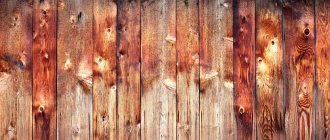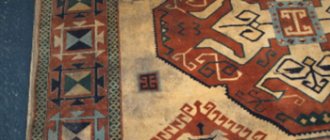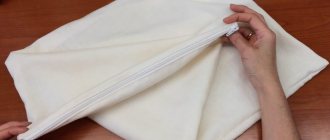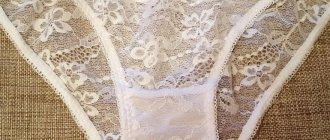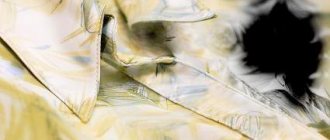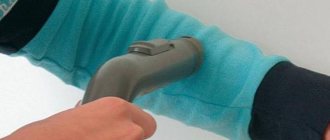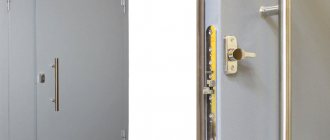Flooding from above most often does not go away without leaving a trace, and, at a minimum, color stains or damage remain on the ceiling of the apartment below, depending on the finishing material. Let's look at how to remove yellow spots on the ceiling after a flood - these are minimal consequences when the leak did not entail a more serious amount of repair work.
Removing stains on a whitewashed stone ceiling after a leak
This type of construction and finishing material is widespread, and successful cleaning of the ceiling from stains after a leak in this case is a rather labor-intensive operation.
Yellow spots on a whitewashed ceiling after flooding can be eliminated in several ways, but always only after the causes of the leak have been eliminated. As a rule, a combination of several operations is used, since the stains may be accompanied by other damage caused by flooding.
Repair of ceiling finishing using a mechanical method
If a leak on the floor above has caused a layer of putty or plaster to peel off, then these layers must be removed. Use a hammer to pierce the bubble of the shell, and then use a spatula to clean the base of the exfoliated finish. If colored stains have spread to an undamaged finish, then they are removed in an acceptable way - surface stains on the putty are scraped off, deep impregnation is cut down to the plaster layer. After cleaning the base, allow the surface to dry.
If there are areas on the ceiling with exposed steel reinforcement or traces of rust from its proximity, then it is necessary to isolate the steel from the materials of the upcoming finishing. First of all, concrete with traces of rust is tapped with the sharp end of a hammer to identify fragments of nearby reinforcement that have lost their grip with the concrete of the slab.
Visible areas of steel are then cleaned with a stiff steel brush or coarse sandpaper, followed by two coats of paint (ideally with a rust converter), being careful not to paint over the concrete around them. In this way, the reinforcement is protected from contact with residual moisture in the slab and corrosion, which would otherwise appear through the putty layer within a day or two after its application, since the leveling mixture includes various technological additives that oxidize iron.
Important! It is impossible to cut out the reinforcement exposed in the slab - it is an integral element of the reinforcing mesh and even in this form continues to perform part of its functions.
After the protective layer of paint on the reinforcement has dried, the defective areas of the surface are primed with an aqueous solution of latex in a ratio of 1:3 or another ready-made composition suitable for this purpose.
If at the beginning of the operation, after removing the peeling finish, no exposed reinforcement is found, then the repaired surface fragment is only primed after drying. This is done in order to stick the dust to the base and increase the adhesion of the leveling mixture, which will be applied to it after the primer has dried.
Moisture-resistant cement-based leveling mixtures, including tile adhesive, are well suited for filling potholes in the ceiling. The composition prepared according to the instructions on the packaging is applied in layers - each subsequent layer is laid after the previous one has cured, but before it dries, it should be taken into account that the last laying should not be flush, since the finishing will still be done on top of it with gypsum-based putty.
The final leveling, depending on the qualifications of the performer, is carried out in one or two layers on top of the hardened cement composition. Grinding of the repaired area is carried out after the gypsum putty and the layers under it have completely dried - this will be evidenced by the uniform pure white color of the surface.
Before painting the area, it must be primed. It should be borne in mind that a freshly painted surface will differ from the rest of the area in greater color intensity, even if the ceiling is white - there is dust on the old emulsion, the directions of movement of the brush, roller or spray gun will be different, etc. Therefore, if the goal is to remove yellow spots on the ceiling without a trace, then you will have to paint the entire surface of the base, and, depending on the quality of the emulsion, in 2-3 layers.
Repair of ceiling finishing using chemicals
When flooding in an apartment on the floor above has been quickly eliminated, or the waterproofing of the floor there has been done well enough, the consequences of water leakage through the interfloor ceiling may only appear in the form of brown stains on the ceiling - there may not be any damage to the plaster and putty.
When choosing a method for washing the ceiling in this case, you should proceed from the fact that it will not be possible to get rid of yellow stains without a trace by washing alone - they will have to be removed using a set of measures.
Yellow stains remaining on the ceiling after flooding have many components, for which there is no universal remedy for neutralizing. It is absurd to do a chemical analysis of these colored stains to successfully remove them, so stains on the ceiling after a flood can be temporarily made as inconspicuous as possible, and then removed completely. If there is no time to remove them in a more efficient mechanical way, such stains must be removed in stages.
Cleaning the ceiling from this dirt begins with removing the damaged layer of emulsion with a spatula - this is easy to do while the ceiling is damp, and the paint is removed in solid strips. If you leave the paint and all subsequent operations are carried out on top of it, it will still peel off, and the texture of the repaired area will be ugly.
Then, after the ceiling has completely dried, the surface is degreased with a nitro solvent, for example, brand “646” or “647”, which will remove possible contamination from the base with oils that got there with water leakage.
Degreasing in the future will allow you to clean stains from the ceiling not only superficially, but also in the thickness of the leveling layers. The operation is carried out with a soft rag made of natural fabric, sufficiently soaked in the substance - the colored stains are wiped over the entire area.
After degreasing is done, we get rid of the coloring pigment of the stains. This is done by using any household detergent containing chlorine - bleaches “Belizna”, “AS”, “Domestos”, chlorine-containing compounds “Dichlor” and “Chlorin”. The presence of chlorine in the composition of the drug is indicated by applying the Cl marking to the packaging.
These or identical products will reduce the brightness of yellow spots on the ceiling, discoloring them to some depth. To do this, protect the floor under the stain with a sheet of cellophane, put on safety glasses and pour the solution into the bath. After soaking a piece of foam rubber in a chlorine-containing product, the sponge is briefly applied to the dirty area to saturate it with bleach. Prolonged impregnation may lead to peeling of the putty layer, which will then have to be removed, so the condition of the impregnated area should be monitored.
Periodically, the tampon is wrung out and washed in a bowl. When a significant loss of color with a cessation of progress is visually noticeable on the contaminated surface, the procedure is stopped and the ceiling is given another hour of time for the absorbed bleach chlorine to complete its reaction with the pigments.
Important! When working with bleaches and solvents, in order to avoid chemical burns, it is necessary to use personal protective equipment (goggles, mask) and ventilate the room.
After an hour, washing the ceilings continues, but using ordinary detergents - washing powder, laundry soap, etc. The purpose of this stage of the procedure is to remove contaminants of other origins, as well as bleach chlorine, from the surface by wiping with a clean rag and applied detergent.
The work is completed by cleaning the base with a piece of foam rubber moistened in clean water until any residual detergent is removed from the surface.
The final result will be visible after the ceiling has dried - in 1-2 days. You should not expect a 100% result and continue to wash the ceiling after drying, since it is impossible to remove yellow stains without a trace in this way. But the contamination after such treatment will become much less noticeable, especially after a masking layer of emulsion of a selected color is applied to the washed area, and more thorough cosmetic repairs can be postponed until better times.
In addition, when painting ceilings treated in this way, surprises in the form of endlessly appearing dirty red stains are excluded - after one coating of the surface with a primer, the number of layers of emulsion required for finishing will be minimal.
Causes of stain formation
Content
Yellow stains on the ceiling appear under the influence of moisture. It can get there as a result of a roof leak, loss of pipeline tightness, or flooding by neighbors above who forgot to turn off the tap.
Sometimes it is not possible to immediately determine the cause of the appearance of water. You may think that your neighbors are flooding you, but in fact the problem will be caused by an invisible leak of a rusty pipe in the interfloor space.
But until the cause of the stains is completely eliminated, the repair will be temporary.
Repair after flooding of plasterboard ceilings
There is a moisture-resistant type of plasterboard sheets - GKLV, which is used to level bases in rooms with high humidity. But even this material is not designed for prolonged direct contact with water, since gypsum is hygroscopic.
There is no specific answer to the question of how to clean a plasterboard ceiling when it is flooded from above. If the gypsum boards were treated with a hydrophobic compound before installation, the duration of contact with water was short, and the gypsum board finishing did not have time to deform, then how to wash the ceiling depends on the finishing material on top of the plasterboard.
What to do with a ceiling made of painted plasterboard
The emulsion will have to be carefully removed with a spatula while it is still damp, being careful not to damage the reinforcing shell of the gypsum board. Then the finish is given time to dry, after which it is primed with an aqueous solution of latex and, again after it has dried, a layer of finishing gypsum putty is applied. The final finish is sanded, primed again and coated with an emulsion of a selected color. If you paint only the area being repaired, then it will stand out against the general background in any case.
How to get rid of stains on ceiling wallpaper
If wallpaper was glued on top of the ceiling, including plasterboard, then, as a rule, it peels off from the damp base and also becomes covered with dirty yellow spots. It will not be possible to wash such wallpaper to its original condition, but if the gypsum plasterboard base was preserved or repaired, you can glue it back in place, and then completely paint the ceiling. Spot repairs to wallpaper (replacing a strip or section) will be visible visually, even if the material is from the same batch.
Stains on gypsum boards without finishing
The situation with stains on the drywall itself is not relevant - gypsum board is almost never used without decorative finishing, so after flooding, it is not the appearance of stains that is important, but the preservation of the strength characteristics and geometry of the sheets. If a section of gypsum board has become unusable, you can replace both the entire sheet and its fragment if it is small in area.
Replacing a fragment begins with cutting out the defective area and attaching bars or pieces of a CD profile to the base for mounting a new fragment on them - the same in configuration and thickness.
The gypsum board insert is cut out in such a way that after installation in place there are gaps of 3-5 mm around the perimeter. After attaching the insert to the base, the joints are aligned flush with the ceiling - the edge is wedged in the opening with wedges, aligning the height along the perimeter. Then the joints are filled with a special mixture for gypsum board joints.
A day later, after the composition has cured, the wedges are removed, and the nests remaining after them are also filled with putty. Then the joints are glued with sickle tape and a finishing layer of gypsum putty is applied.
Kitchen grease marks
Greasy yellow stains in the kitchen are easier to remove while they are fresh. To do this, you need a regular soap solution and a sponge. But after they have become thoroughly ingrained into the ceiling, you need to use a stronger product.
- Take a 2% soda ash solution and heat until hot.
- Soak a white cloth in the solution, wring it lightly and apply to the stain for a few seconds.
- After this, use diluted detergent.
- Dry the ceiling thoroughly.
Restoring PVC tile ceiling cladding after a leak
PVC tiles are a waterproof material, and flooding does not change its characteristics, but yellow stains after a leak from above remain on it. It will not be possible to wash the tiles to their original state - contamination penetrates into the structure of the material due to its low density. But the way to get rid of the consequences of flooding is not technically difficult to implement.
Using a piece of foam rubber soaked in water and detergent, wash away dirt from the finish as much as possible (the use of chlorine-containing compounds is also acceptable). Then the tiles are primed with a latex-based composition to form a film over the remaining dirt and, after the primer has dried, they are painted with emulsion paint in any color you like.
Oil stains
Finishing the ceiling with oil paints can cause many difficulties later. The oil penetrates deeply into the floor slab and may appear over time, even if the painted layer is completely removed. But what to do in this case?
- Be patient and prepare a wide spatula, deep penetration primer, water-based paint, brush or roller.
- Remove damaged plaster using a spatula.
- Apply primer in one layer.
- After the ceiling has dried, it must be carefully painted over.
- To prevent the stain from showing through, it is necessary to apply several layers of paint.
We recommend: How to repair the lid of different models of the Redmond multicooker
Restoration of suspended ceilings after flooding from above
Water leaks do not go unnoticed for suspended ceilings either - yellow spots can appear even after a long time after minor flooding, which went unnoticed under the fabric. The method of eliminating them depends on the material of the stretch ceiling and the nature of the contamination.
If the ceiling is elastic synthetics, film, and the cause of yellow or other colored stains is moisture, then the easiest way is to use one of the special products for cleaning suspended ceilings (solution, spray, gel).
The method of use is outlined on the packaging of the composition, and the effectiveness of the operation depends on the quality of the product and the conscientiousness of the cleaning.
In the absence of such a means, improvised materials are used.
For example, a swab is made of cotton wool and gauze, which, after wetting it in a ten percent solution of ammonia, is used to wipe the stains, going beyond their boundaries by 10-15 cm. If, after such cleaning, the area differs from the main background in color, then it is necessary to wash the entire ceiling using regular detergents to remove dust and dirt.
Leak stains on a film stretch ceiling can also be removed using soda ash - a five percent aqueous solution is applied to the stains and, after drying, washed off with warm, clean water.
Due to the smooth structure of the surface, removing stains from an elastic stretch ceiling is easier than from a textile or fabric one. You can use most household detergents (soaps, gels, powders, pastes), with the exception of aggressive acids, alkalis and solvents.
If the stretch ceiling material is textile, then the same means are used, but the process will require more time and effort. However, cleaning even a fabric stretch ceiling will be ensured if the cause of contamination is water - we wipe and wash the textiles to the desired result, using only swabs with a soft fluffy surface and delicate detergents.
In case of more serious contamination, in order to avoid damage to the material, it is better to contact professionals.
Traditional methods for cleaning yellow stains
The methods described below for removing stains after a flood are only suitable for plaster and concrete surfaces:
Citric acid with soda
These substances are mixed in arbitrary proportions to form a mushy substance. It is rubbed into the damaged area, left for 15-20 minutes, and then removed; it is better to use the dry method. This could be a sponge or spatula. The surface can be painted only after the treated area has dried.
Hydrogen peroxide and soda
This mixture is not as concentrated as with citric acid. These substances are also diluted to a porridge state and rubbed into water-damaged areas. After drying, everything is carefully removed with a damp cloth or dry sponge.
Ammonia
It smells very strongly, so first open all the windows so that there is a constant flow of fresh air. Dilute ammonia in a ratio of 1 tbsp. l. per 1 liter of water and wipe the damaged areas. Make sure that nothing comes into contact with your eyes and mucous membranes of the respiratory tract, as well as undamaged areas on the ceiling.
The ammonia should be removed after 10-15 minutes with a damp cloth. Let the ceiling dry thoroughly.
Attention! The methods described above involve preliminary removal of the damaged material. After which you will need to paint or whitewash the ceiling using the method described above.
If the vinyl surface is damaged
The easiest way to remove ceiling stains is from vinyl surfaces. What is the reason? It's simple - there are never any unpleasant yellow spots or streaks left on the vinyl. When flooded, this material acts as a large basin, collecting all the water. The only thing you need to do is carefully remove all moisture. To perform this task, it is optimal to call specialists from the company that did the installation.
However, there are situations when there is no time to wait for specialists to arrive - the bag hanging from the ceiling has reached alarming proportions. This problem should be resolved as quickly as possible. During installation, all vinyl sheets are equipped with decorative inserts with a connecting seam. It is best to look for them in corners. Before removing the inserts, the room must be heated to a temperature of +40°C.
A container of sufficient volume is placed under the area with the inserts and all collected liquid is carefully drained. Before returning the insert to its place, you should thoroughly dry the space between the canvas and the ceiling.
Which is better: heated floors or radiators?
Warm floorBatteries
How to fix paint runs on painted walls
Often, when drips occur, the thought comes to apply another layer of paint. Of course, this option will not solve the problem, since the defect will become even more pronounced. Sometimes when applying a new layer, new drips are added. To avoid this, it is recommended to immediately do everything as carefully as possible and prevent their occurrence.
No one is immune from making mistakes, so the occurrence of leaks should not provoke panic. The main thing here is to be patient and immediately begin eliminating visible defects on the wall surface.
Main stages
- First you need to clean the area with drips from a fresh coat of paint. This work is best done using a special device or regular sandpaper with fine abrasive components.
Note! The process itself must be carried out extremely carefully so as not to damage the top layer of putty.
- The prepared area should be sanded until the surface is perfectly smooth. Then you need to take a slightly dampened rag and wipe the wall or ceiling. At this stage, it is important to inspect the surface for other defects. If this is found, it is recommended to reapply the putty and perform sanding again.
- As soon as the treated area becomes even and smooth, you can proceed to priming. The solution is applied in only one layer and left until completely dry, then the procedure must be repeated. At the end of the work, you need to check the smoothness of the surface. If flaws are identified again, the primer is applied one more time.

